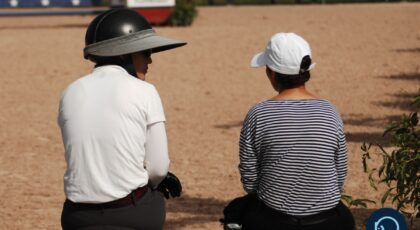Anyone paying a modicum of attention to horse sport the past two years knows that the equestrian industry is on the hot seat—with good reason. We have reached a level of knowledge and understanding of the horse’s brain and how it works, as well as his emotional needs, to require a reset in “traditional” thinking and training methodology. The good news is, there are a lot of people out there doing the research to help us make changes for the good of the horse in order to ensure we can pursue our passion to ride and compete for generations to come.
In her groundbreaking book A Horse By Nature, the first to deal head on with the issue of social license and what we can do to improve equine welfare, longtime researcher and educator Mary Ann Simonds explains that horses who display abnormal behaviors and are unpredictable often have experienced some form of trauma in their lives or learned coping behaviors. In the excerpt from her book that follows, Simonds guides us in understanding how to assess trauma in our horses in order to better help them overcome it and lead happier, healthier lives in our company.
***
Horses do not have to have experienced “trauma” in human terms to have been “traumatized.”
Different aspects of temperament and personality as well as withstanding pain and separation and other variables can all create a “traumatic experience” for a horse. Trauma untreated in horses leads to welfare issues, as many either suffer high states of uncontrolled anxiety, creating potential safety issues for humans, or are passed through the “system,” often ending up at rescue and adoption centers.
Conditions related to trauma usually get labeled as “behavioral issues” or “just the way the horse is,” and the horse never gets the help he needs. All people in a horse’s life, the veterinarian, owner, trainer, farrier, and others, should be able to notice symptoms of trauma and then discuss what is best for the horse to ensure his well-being.
Horses and humans as social mammals share a number of emotional psychological imbalances. Despite this, while human psychology has identified issues such as PTSD (post-traumatic stress disorder) for people, little research has been done on horses who have undergone psychological stress.
With over 40 years of clinical research in treating behavioral issues in horses, it is clear to me that while many issues are related to undiagnosed physical pain or discomfort, often the most dangerous behaviors are related to human ignorance of equine behavior and communication relating to the horse’s mental and emotional states.
Common causes of trauma in horses include:
- Separation from family and friends.
- Inability to make social bonds.
- Accident or event triggering the horse to feel unsafe.
- Restriction when the horse needed to flee.
- Restriction or confinement under unsafe circumstance.
- An event the horse perceived as fearful but did not understand and associated with objects, people, places, smells, or other sensory input with the experience.
- Physical abuse associated with a trigger the horse did not understand.
- Abandonment, including isolation, starvation, and no social interaction.
- Being oversensitive to sensory stimuli and lacking confidence.
Domestic horses with the following abnormal stress behaviors often have experienced trauma:
- Lack of curiosity to interact with humans or novel objects.
- Failure to make any eye contact or show desire to interact with people.
- A “dead” or “dull eye”—no light in the eye, as if staring blankly at all times.
- A worried look in the eyes when around people.
- Looks away or hides head down in corner of stall.
- Panics in small spaces if unable to get away or move.
- Overreaction to stimuli (visual, tangible, audible, olfactory).
- Muscles tighten when touched; acts nervous.
- Unpredictable bolting with no regard for safety.
- Attachment to other horses, but failure to form functional social bonds.
- Bursts of anger toward humans and other horses.
- Abnormal and repetitive “vice” behaviors, such as weaving, self-inflected biting, head-shaking, cribbing, and grinding teeth up and down stall bars.
- Over-responds to training (hyperflexes, for example).
- Holds breath or breathes shallowly when around humans; fails to relax.
- Sweats from nervousness when around people or being ridden.
- Increased heart rate when around people or being handled.
Horses do not have to end up in rescues to have experienced trauma. They don’t have to have been abused. Horses are individuals, and while we can make some generalizations about equine behavior, they are “context-specific,” meaning the same circumstances can affect various horses differently.
For example, the curious, very social, young male horse might not be stressed by weaning, especially if he is with friends during this period and makes new friends easily. In his case, heading off to the track or another new environment might be perceived with some enthusiasm. But a highly sensitive and timid filly, having gone through the same environmental experiences, may have ulcers and never feel relaxed enough to learn how to adjust. From a human perspective, her early life may be perceived as “normal,” but from the filly’s perspective, it is traumatic.
Oftentimes, well-meaning trainers will have a horse who is described as “difficult.”
“Difficult” horses who display normal horse behavior are usually smart horses who have learned ways to protect themselves and communicate to humans their needs. “Difficult” horses who display abnormal horse behavior, such as I’ve just described, and are sometimes unpredictable, most often have had some form of trauma in their lives or have learned coping behavior. Their instinctual drivers are always on “high alert,” but they have no way to find safety. Their stress levels are almost always high and will remain so until someone can help them learn new associations, let go of the trauma, and find comfort.
Stereotypic behaviors, such as “cribbing” and weaving, are examples of what can be coping behavior (acquired due to confinement, for example). The underlying cause of stereotypic behaviors should be identified and addressed as they are often associated with poor mental, emotional, or physical welfare. Luckily, horses are very forgiving, and given a chance, will undo negative associations in exchange for a positive association, thus removing the trauma.
Most trauma in horses can be corrected by assessing the core of the issue, building trust with the horse, and gently recreating any triggers using positive rewards. Helping a horse feel safe, making him comfortable, and giving him a choice when it comes to interaction with humans are essential first steps. But we must always be aware that a deep-seated trigger can override thinking in the horse and cause panic. It is critical we create safe space and be the eyes and ears for the horse.

This excerpt from A Horse By Nature by Mary Ann Simonds is reprinted with permission from Trafalgar Square Books (trafalgarbooks.com).


 December 23, 2024
December 23, 2024 

























